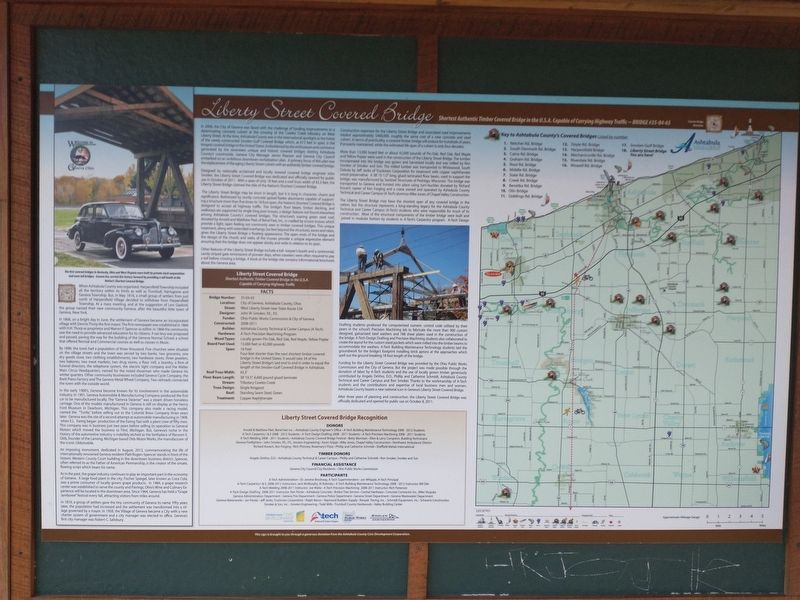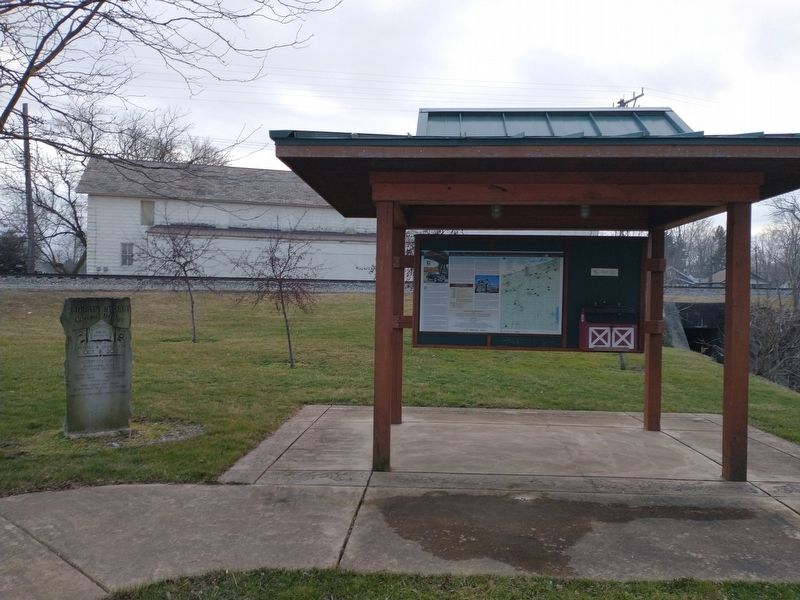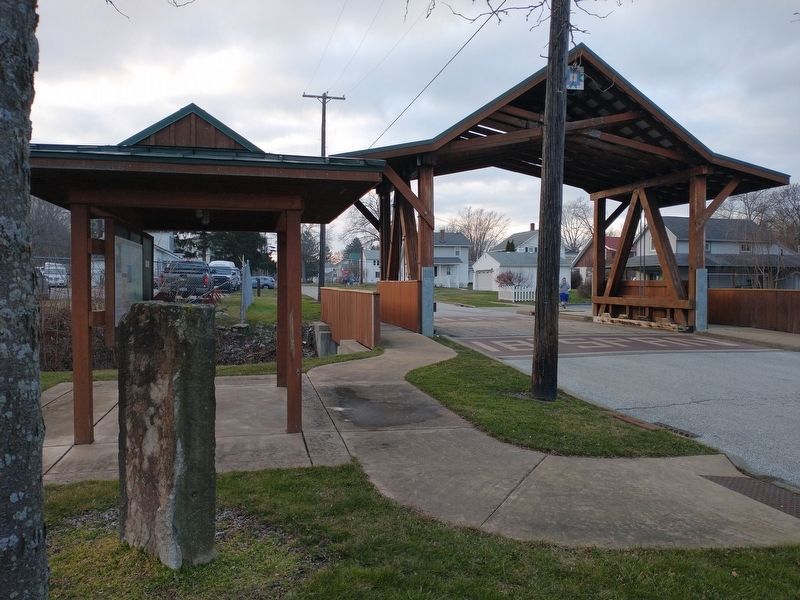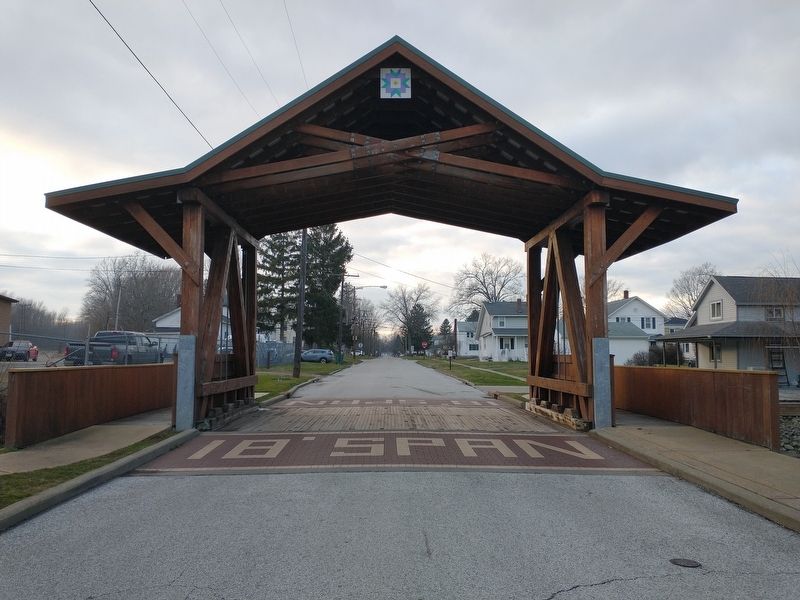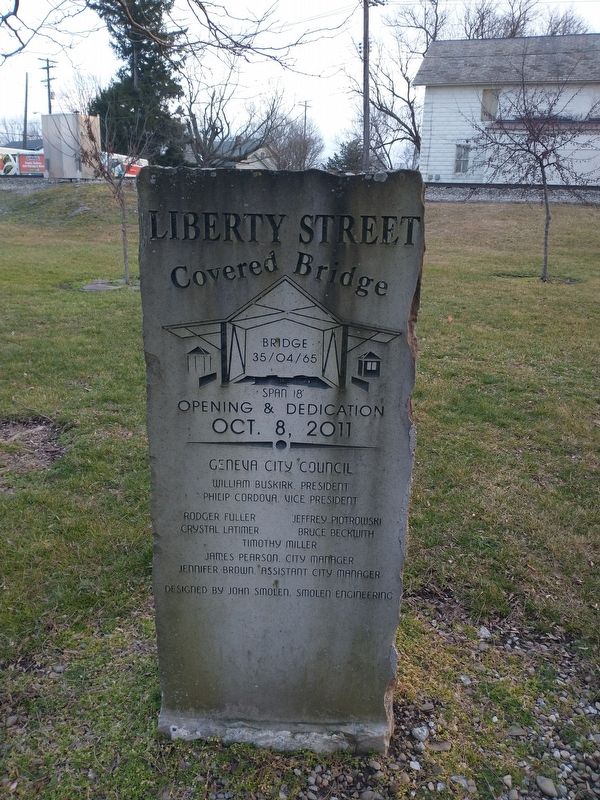Geneva in Ashtabula County, Ohio — The American Midwest (Great Lakes)
Liberty Street Covered Bridge
Shortest Authentic Timber Covered Bridge in the U.S.A. Capable of Carrying Highway Traffic
— Bridge #35-04-65 —
Welcome To Geneva, Ohio
The first covered bridges in Kentucky, Ohio and West Virginia were built by private stock corporations and were toll bridges. Geneva has carried this history forward by providing a toll booth at the Nation's Shortest Covered Bridge.
When Ashtabula County was organized, Harpersfield Township included all the territory within its limits as well as Trumbull, Hartsgrove and Geneva Township. But, in May 1816, a small group of settlers from just north of Harpersfield Village decided to withdraw from Harpersfield Township. At a mass meeting, and at the suggestion of Levi Gaylord, the group named their new community Geneva, after the beautiful little town of Geneva, New York.
In 1866, on a bright day in June, the settlement of Geneva became an incorporated village with Dennis Thorp the first mayor. The first newspaper was established in 1866 with H.H. Thorp as proprietor and Warren P. Spencer as editor. In 1868 the community saw the need to provide advanced education for its citizens. A tax levy was proposed and passed, paving the way for the building of the Geneva Normal School, a school that offered Normal and Commercial courses as well as classes in Music.
By 1896, the town had a population of three thousand. Five churches were situated on the village streets and the town was served by two banks, two groceries, one dry goods store, two clothing establishments, two hardware stores, three jewelers, two bakeries, two meat markets, two drug stores, a flour mill, a laundry, a firm of funeral directors, the telephone system, the electric light company and the Walter Main Circus Headquarters, named for the noted showman who made Geneva his winter quarters. Other community businesses included Geneva Cycle Company, the Brett Piano Factory and The Geneva Metal Wheel Company. Two railroads connected the town with the outside world.
In the early 1900's, Geneva became known for its involvement in the automobile industry. In 1901, Geneva Automobile & Manufacturing Company produced the first car to be manufactured locally. The "Geneva Steamer” was a steam driven horseless carriage. One of the models manufactured in Geneva is still on display at the Henry Ford Museum in Dearborn, Michigan. This company also made a racing model, named the "Turtle,” before selling out to the Colonial Brass Company three years later. Geneva was the site of a second attempt at automobile manufacturing in 1908, when E.L. Ewing began production of the Ewing Taxi with a plant crew of fifty men. This company was in business just two years before selling its operation to General Motors which moved the business to Flint, Michigan. But, Geneva's niche in the history of the automotive industry is indelibly etched as the birthplace of Ransom E. Olds, founder of the Lansing, Michigan based Olds Motor Works, the manufacturer of the iconic Oldsmobile.
An imposing monument, dedicated in August, 2012, commemorating the life of internationally renowned Geneva resident Platt Rogers Spencer stands in front of the historic Western County Court building in the downtown business district. Spencer, often referred to as the Father of American Penmanship, is the creator of the ornate, flowing script which bears his name.
As in the past, the grape industry continues to play an important part in the economy of Geneva. A large food plant in the city, Fischer Spiegel, later known as Coca Cola, was a prime consumer of locally grown grape products. In 1984, a grape research center was established to serve the county and Pairings, Ohio's Wine and Culinary Experience will be located in the downtown area. Since 1964, Geneva has held a "Grape Jamboree festival every fall, attracting visitors from miles around.
In 1816, a group of settlers gave the tiny community of Geneva its name. Fifty years later, the population had increased and the settlement was transformed into a village governed by a mayor. In 1958, the Village of Geneva became a City with a new charter system of government and a city manager was elected to office. Geneva's first city manager was Robert C. Salisbury.
In 2008, the City of Geneva was faced with the challenge of funding improvements to a deteriorating concrete culvert at the crossing of the Cowles Creek tributary on West Liberty Street. At the time, Ashtabula County was in the international spotlight as the home of the newly constructed Smolen-Gulf Covered Bridge which, at 613 feet in span, is the longest covered bridge in the United States. Emboldened by the enthusiasm and commerce generated by the seventeen unique and historic covered bridges dotting Ashtabula County's countryside, Geneva City Manager James Pearson and Geneva City Council embarked on an ambitious downtown revitalization plan. A primary focus of this plan was the replacement of the aging Liberty Street culvert with an authentic timber covered bridge.
Designed by nationally acclaimed and locally revered covered bridge engineer John Smolen, the Liberty Street Covered Bridge was dedicated and officially opened for public use in October of 2011. With a span of only 18 feet and a roof truss width of 43.3 feet, the Liberty Street Bridge claimed the title of the Nation's Shortest Covered Bridge.
The Liberty Street Bridge may be short in length, but it is long in character, charm and significance. Buttressed by sturdy concrete spread footer abutments capable of supporting a structure more than five times its 18 foot span, the Nation's Shortest Covered Bridge is designed to accept all highway traffic. The bridge's floor beam, timber decking, and walkways are supported by single king post trusses, a design feature not found elsewhere among Ashtabula County's covered bridges. The structure's soaring green steel roof, donated by Arnold and Matthew Peet of Bend-Fast, Inc., is cradled by scissor trusses which provide a light, open feeling not commonly seen in timber covered bridges. This unique treatment, along with extended overhangs (six feet beyond the structure), eaves and rakes, gives the Liberty Street Bridge a floating appearance. The open ends of the bridge and the design of the chords and webs of the trusses provide a unique expressive element ensuring that the bridge does not appear stocky and wide in relation to its span.
Other features of the Liberty Street Bridge include a toll- keeper's booth and a ceremonial, candy striped gate reminiscent of pioneer days, when travelers were often required to pay a toll before crossing a bridge. A kiosk at the bridge site contains informational brochures about the Geneva area.
Construction expenses for the Liberty Street Bridge and associated road improvements totaled approximately $400,000, roughly the same cost of a new concrete and steel culvert. In terms of practicality, a covered timber bridge will endure for hundreds of years, if properly maintained, while the estimated life span of a culvert is only four decades.
More than 13,000 board feet or about 42,000 pounds of Pin-Oak, Red Oak, Red Maple and Yellow Poplar were used in the construction of the Liberty Street Bridge. The lumber incorporated into the bridge was grown and harvested locally and was milled by Ron Smoker of Smoker and Son. The milled lumber was transported to Whitewood, South Dakota by Jeff Jenks of Truckmen Corporation for treatment with copper naphthenate wood preservative. A 38' 10 1/2” long, glued laminated floor beam, used to support the bridge, was manufactured by Sentinel Structures of Peshtigo, Wisconsin. The bridge was transported to Geneva and hoisted into place using turn-buckles donated by Richard Kovach owner of Ken Forging and a crane owned and operated by Ashtabula County Technical and Career Campus (A-Tech) alumnus Mike Jones of Chapel Valley Construction.
The Liberty Street Bridge may have the shortest span of any covered bridge in the nation, but the structure represents a long-standing legacy for the Ashtabula County Technical and Career Campus (A-Tech) students who were responsible for much of its construction. Most of the structural components of the timber bridge were built and joined in modular fashion by students in A-Tech's Carpentry program. A-Tech Design Drafting students produced the computerized numeric control code utilized by their peers in the school's Precision Machining lab to fabricate the more than 900 custom designed, galvanized steel washers and 768 shear plates used in the construction of the bridge. A-Tech Design Drafting and Precision Machining students also collaborated to create the layout for the custom sized pockets which were milled into the timber beams to accommodate the washers. A-Tech Building Maintenance Technology students laid the groundwork for the bridge's footprint installing brick aprons at the approaches which spell out the ground breaking 18 foot length of the bridge.
Funding for the Liberty Street Covered Bridge was provided by the Ohio Public Works Commission and the City of Geneva. But the project was made possible through the donation of labor by A-Tech students and the use of locally grown timber generously contributed by Angelo DeVivo, D.O., Phillip and Catherine Schmidt, Ashtabula County Technical and Career Campus and Ron Smoker. Thanks to the workmanship of A-Tech students and the contributions and expertise of local business men and women, Ashtabula County boasts a new national icon in Geneva's Liberty Street Covered Bridge.
After three years of planning and construction, the Liberty Street Covered Bridge was officially dedicated and opened for public use on October 8, 2011.
Liberty Street Covered Bridge
Shortest authentic timber covered bridge in the U.S.A. capable of carrying highway traffic
Facts
Bridge Number: 35-04-65
Location: City of Geneva, Ashtabula County, Ohio
Street: West Liberty Street near State Route 534
Designer: John W. Smolen, P.E., P.S.
Funder: Ohio Public Works Commission & City of Geneva
Constructed: 2008-2011
Builder: Ashtabula County Technical & Career Campus (A-Tech)
Hardware: A-Tech Precision Machining Program
Wood Types: Locally grown Pin-Oak, Red Oak, Red Maple, Yellow Poplar
Board Feet Used: 13,000 feet or 42,000 pounds
Span: 18 Feet
Four-feet shorter than the next shortest timber covered bridge in the United States. It would take 34 of the Liberty Street Bridge's laid end to end in order to equal the length of the Smolen-Gulf Covered Bridge in Ashtabula.
Roof Truss Width: 43.3'
Floor Beam Length: 38'10.57,4,600 pound glued laminate
Stream: Tributary Cowles Creek
Truss Design: Single Kingpost
Roof: Standing Seam Steel, Green
Treatment: Copper Naphthenate
Topics and series. This historical marker is listed in these topic lists: Bridges & Viaducts • Roads & Vehicles. In addition, it is included in the Covered Bridges series list. A significant historical month for this entry is May 1816.
Location. 41° 47.945′ N, 80° 56.903′ W. Marker is in Geneva, Ohio, in Ashtabula County. Marker is on West Liberty Street west of South Broadway (Ohio Route 534), on the right when traveling east. Touch for map. Marker is at or near this postal address: 94 W Liberty St, Geneva OH 44041, United States of America. Touch for directions.
Other nearby markers. At least 8 other markers are within 5 miles of this marker, measured as the crow flies. Ransom E. Olds-Birthplace (approx. 0.4 miles away); Harpersfield (approx. 1.1 miles away); Harpersfield Covered Bridge (approx. 3 miles away); a different marker also named Harpersfield (approx. 3.1 miles away); Colonel Alexander Harper (approx. 3.1 miles away); Unionville Tavern (approx. 3.1 miles away); Shady Beach (approx. 4.2 miles away); The Popcorn Ball (approx. 4.2 miles away). Touch for a list and map of all markers in Geneva.
Credits. This page was last revised on January 25, 2023. It was originally submitted on January 17, 2023, by Craig Doda of Napoleon, Ohio. This page has been viewed 126 times since then and 35 times this year. Photos: 1, 2, 3, 4, 5. submitted on January 17, 2023, by Craig Doda of Napoleon, Ohio. • Devry Becker Jones was the editor who published this page.
